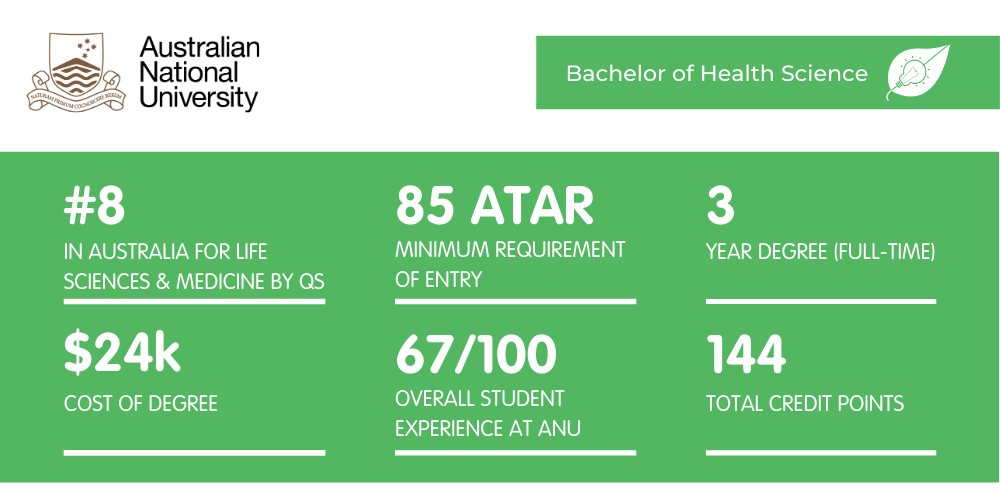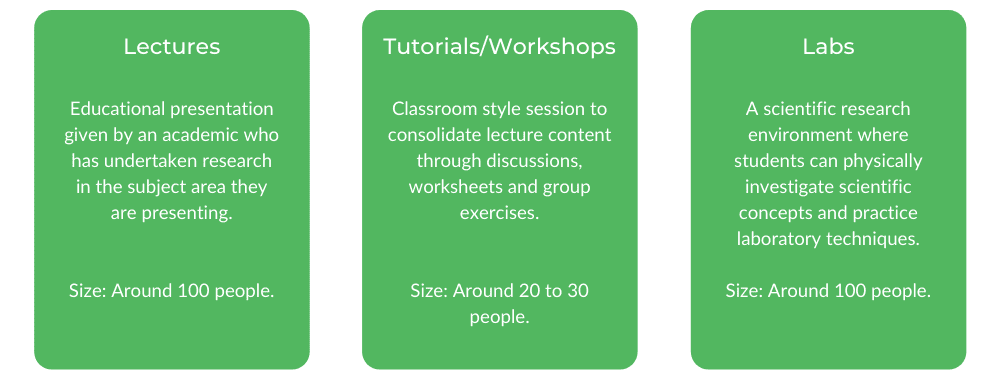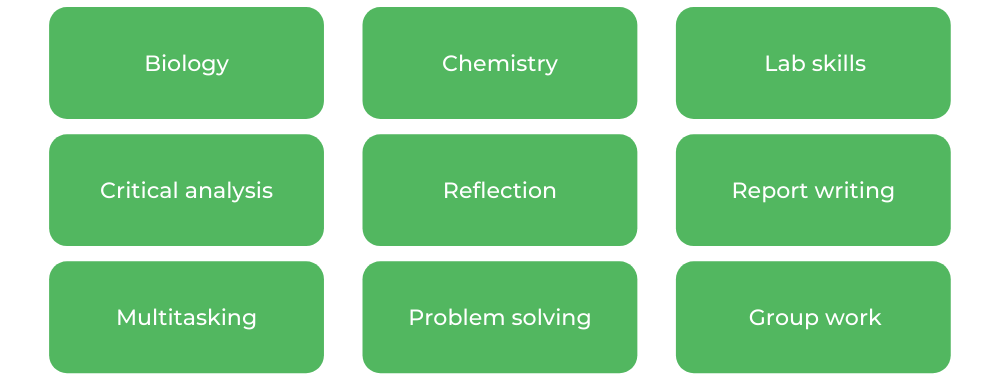
Interested in medicine, science, public health or how all of these topics intersect? Maybe you’re thinking about an ANU Health Science degree?
We’ve got you! Whether you’re keen to move into postgraduate medicine, public health or simply gain a detailed understanding of health, we’ve got all the info you need to help you decide if it’s a degree you’d like to pursue.
Keep reading to learn all about it!
What is a Bachelor of Health Science at ANU?
Core Units for this Degree
How to Get into a Bachelor of Health Science at ANU
What’s the Teaching Format?
What’s the Faculty and Culture Like?
What is a Bachelor of Health Science at ANU?
A Bachelor of Health Science at ANU covers topics of health, social science and the basics of medicine. It’s a degree that provides a well-rounded view of the science behind our bodies, whilst promoting information about the social constructs that affect our health.
You’ll also gain understanding of the public policy that backs medicine in Australia.
This broad degree also offers a great advantage to aspiring doctors — each year, up to 30 students will be offered entry into medicine without having to sit the GAMSAT! This will take a lot of stress off as your study progresses.
Honours
Students with a WAM over 70 can study this degree with Honours, which is an additional year of study at the end of the degree. However, this is not a requirement to enter postgrad medicine.
Career Paths
As discussed, this is a course that sets you up for further study. Many students venture into postgraduate degrees once their Bachelor’s degree is completed.
However, there are still some great careers that you can take on right out of study, including:
- Mental health worker (often with further study)
- Wellbeing manager
- Telehealth coach
- Environmental health officer
- Lifestyle coach
- Researcher
Core Units for this Degree
The Bachelor of Health Science is a rather regimented degree, meaning you’ll be taking on a lot of core units with minimal electives. This may sound daunting, however it assures you’re on the right path for your future.
Units are broken down by levels. Students must complete at least 60 units of 1000-level courses, and 30 units of 3000-level courses. The compulsory subjects include:
First Year
- Biology 2: Molecular and Cell Biology
- Human Biology
- Health in the 21st Century
- Research Methods in Health Sciences
In these first year subjects, students gain an overview of health and biology.
Human Biology gives an overview of how we function, with an emphasis on organ systems, infections and immunity. Students then tackle Biology 2, which breaks down functioning on a cellular level.
Health subjects in first year focus on theories and practice, including identifying a topic for inquiry, reviewing literature and finding gaps in evidence. This is complemented by an understanding of health today.
Second Year
- Health Systems and Policy: An introduction
- Introduction to global health
- Medical Physiology and Pharmacology
- Pathogenesis of Human Disease
Second year is where it starts getting more specific. Students study two health subjects, which look more at health as a global and social issue.
In Health Systems and Policy, students learn about the World Health Organisation model and the Australian healthcare system. You will also examine the layers that make up such a system, including funding, workforce issues, governance and policy process.
This is expanded in Introduction to Global Health, which outlines key stakeholders in global health and the status of healthcare in other countries.
In Pathogenesis of Human Disease, students deep dive into the understanding of illness, including courses of and normal responses to disease. You will also learn about medical theories and ways of giving a clinical diagnosis.
Medical Physiology and Pharmacology will teach you key scientific principles that underpin the function of a healthy body. You’ll be involved in a lot of hands-on laboratories.
Third Year
- Aboriginal and Torres Strait Islander Health
- Professional Practice in Health Science
- Health Promotion Principles and Practice
Third year is really all about putting what you’ve learnt into practice and exploring the professions to which your degree could take you.
Aboriginal and Torres Strait Islander Health allow students to develop an understanding of issues confronting Indigenous Australia and the solutions that can be found.
In Health Promotions Principles and Practice, students gain an overview of factors that influence health in society and how knowledge of these factors can be used to solve problems. Students work within a group to identify an issue and develop a health promotion initiative, with evaluation.
Professional Practice in Health Science, is the capstone subject for this degree, in which students apply their understanding to complex case studies, working on solutions and evaluation. Students develop skills including effective teamwork, self awareness and evidence-based practice.
Whilst completing these compulsory courses, students take on subjects either related to Applications of Health or Pre-Medicine. The full break-down for these subjects can be found here.
Internships and Work Experience
This degree doesn’t require students to undertake internships or placements. However, there are a couple of options if you’d like to expand your practical knowledge.
These placements are continually changing, but generally occur during STUVAC in rural places. You can find out more here.
How to Get into a Bachelor of Health Science at ANU
The minimum ATAR for entry into this degree is 85. However, you will also be assessed on your English language proficiency and your answers to a Bachelor of Health Science Supplementary Form. In this form, you will write about your previous achievements, your reason for selecting this course, and any relevant experience.
If you are entering the course straight after Year 12, you’ll also be asked to complete a co-curricular and service requirement demonstrating your involvement in activities outside the classroom during Year 10-12. This could be sport, work, volunteering and more.
Learn about other Health Science degrees at the universities below:
Prerequisites
Whilst there are no formal prerequisites for this degree, some electives do have their own requirements attached. These generally relate to chemistry and maths, which you can find information for here.
Scholarships
ANU has a variety of health-related scholarships available. The ANU All-Rounder Scholarship is offered to students who receive an offer to an undergraduate program and achieve an ATAR of 90 or above.
Other scholarships can be found here!
What’s the Teaching Format?
ANU works via semesters, with an Autumn and Spring session each year. Students generally have 8 hours per week per course — that’s around 25 face-to-face hours per week!
Class Structure

Lectures
Lectures average 100 people per class, but sometimes climb to 400 for shared science subjects! These classes are a great way to learn the theoretical concepts behind subjects in a large teaching setting.
Students learn information that can be extrapolated in smaller classes, later. Lectures are often the time of introduction of a new topic, via the teaching of experts.
Tutorials and Workshops
Tutorials and workshops, which usually have 20 to 30 people in a class, are compulsory. These sessions run for 2-3 hours and are a way to consolidate all information taught in lectures and readings.
They are an opportunity to look at experiment results, ask questions about concepts and collaborate with your class.
Labs
Everyone’s favourite — the practical class! Labs often have 100 people broken into smaller groups. These are classes in which people design, evaluate and perform experiments.
They are very common in science and medicine-based subjects. Labs really let you see different theories in action!
Assessments
As you can see from the subject breakdown, classes are generally split into science, medicine and health classes (with some electives mixed in).
Health/social science classes usually have assessments that are assignment-based and involve writing, including justifying your rationale for certain kinds of thinking.
Science and medicine classes often have more practical assessments and labs. They generally consist of mid-semester and end of semester exams, with smaller quizzes scattered throughout.
Skills You Refine and Learn

As this degree is a hybrid of science, maths, health and social studies, you’ll develop a broad range of skills. These are honed from class activities, which involve multitasking and working with others.
Some of the skills you will refine include:
- Biology
- Chemistry
- Lab skills
- Critical analysis
- Reflection
- Report writing
- Multi-tasking
- Problem solving
- Group work
When you’re in a lab, it’ll be all hands on deck to develop your science abilities, including designing and drafting of experiments. On an academic level, extended response questions will expand your writing skills. This includes evaluation discussion of core concepts.
“Skills stem from the degree being cross-disciplinary.” — Michael Stevens, Bachelor of Health Science III at ANU
What’s the Faculty and Culture Like?

The Bachelor of Health Science has a small cohort of only 60 students per year, which gives you a great opportunity to get to know your classmates.
As most people are keen on studying postgraduate medicine, this is a competitive degree. It’s an intimate competition too — you know a lot of your cohort, so naturally you know who you’re up against.
However, students seem to love the vibe of ANU. As an academic university with leading experts and researchers, you know you’ll be in great hands to pursue your Health Science degree.
The Science Society of ANU
The Science Society of ANU, which is run under the broader banner of ANU Students’ Association (ANUSA), is one you might want to join! This society aims to foster great friendships among STEM students and provide social opportunities during uni, including pub crawls, sport activities, career talks and activities during National Science Week.
Accessibility Programs
ANU prides itself on being accessible, and as such has a number of programs that are available to new and existing students.
The ANU Access Program is a ten-week intensive course that has a focus on English academic skills. It is ideal for students from an EAL background, or who need to develop key academic skills.
You can also find help through Access and Inclusion, who aim to support ANU students who experience disability, issues of physical access or need special exam arrangements. If you are eligible for help, you may be appointed a DisAbility and Equity Advisor who can help you adjust to ANU life. They may also develop your Education Access Plan.
If you’d just like some general support, including feedback on assignments, you can find student tutors located in the ANU Chifley Library. These are generally older students who have experience in your subject area and are keen to help others learn.
Similarly, you can find Academic Skills help online here, available to all enrolled students.
Mentoring at ANU
When you commence your study, you can find help from a semester-long mentoring program called SET4ANU. Here, you can learn more about how to navigate the hefty admin of uni, enrol in courses, find your way around campus and meet other like-minded people. This is a great way to really settle into uni life, right away!
Is a Bachelor of Health Science at ANU sounding like an ideal degree? We hope this article has helped understand exactly what your study experience will be like!
Want to learn about the pros and cons of this degree? Check out our article here!
Lucinda Garbutt-Young hopes to one day be writing for a big-shot newspaper… or maybe just for a friendly magazine in the arts sector. Right now, she is enjoying studying a Bachelor of Public Communication (Public Relations and Journalism) at UTS while she writes on the side. She also loves making coffees for people in her job as a barista, and loves nothing more than a sun shower.


